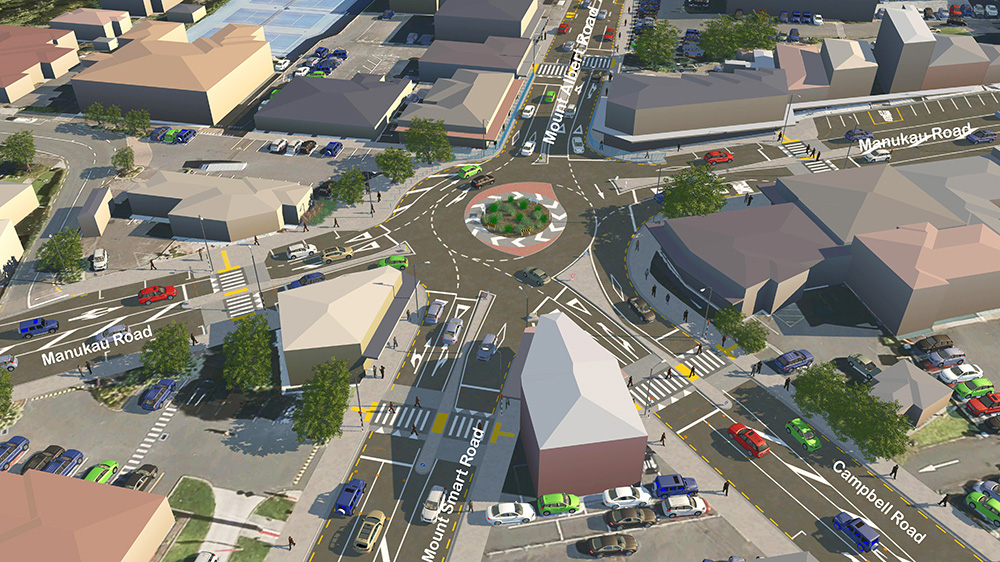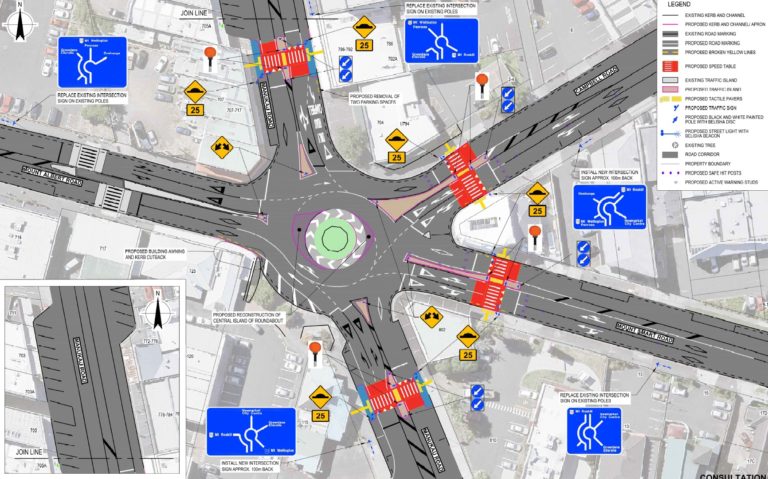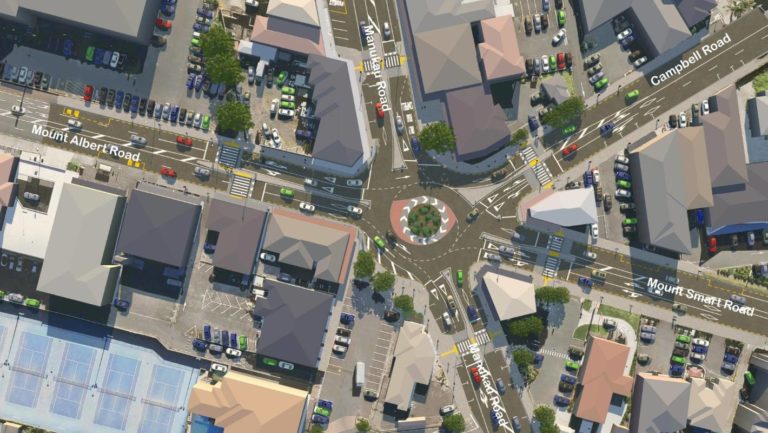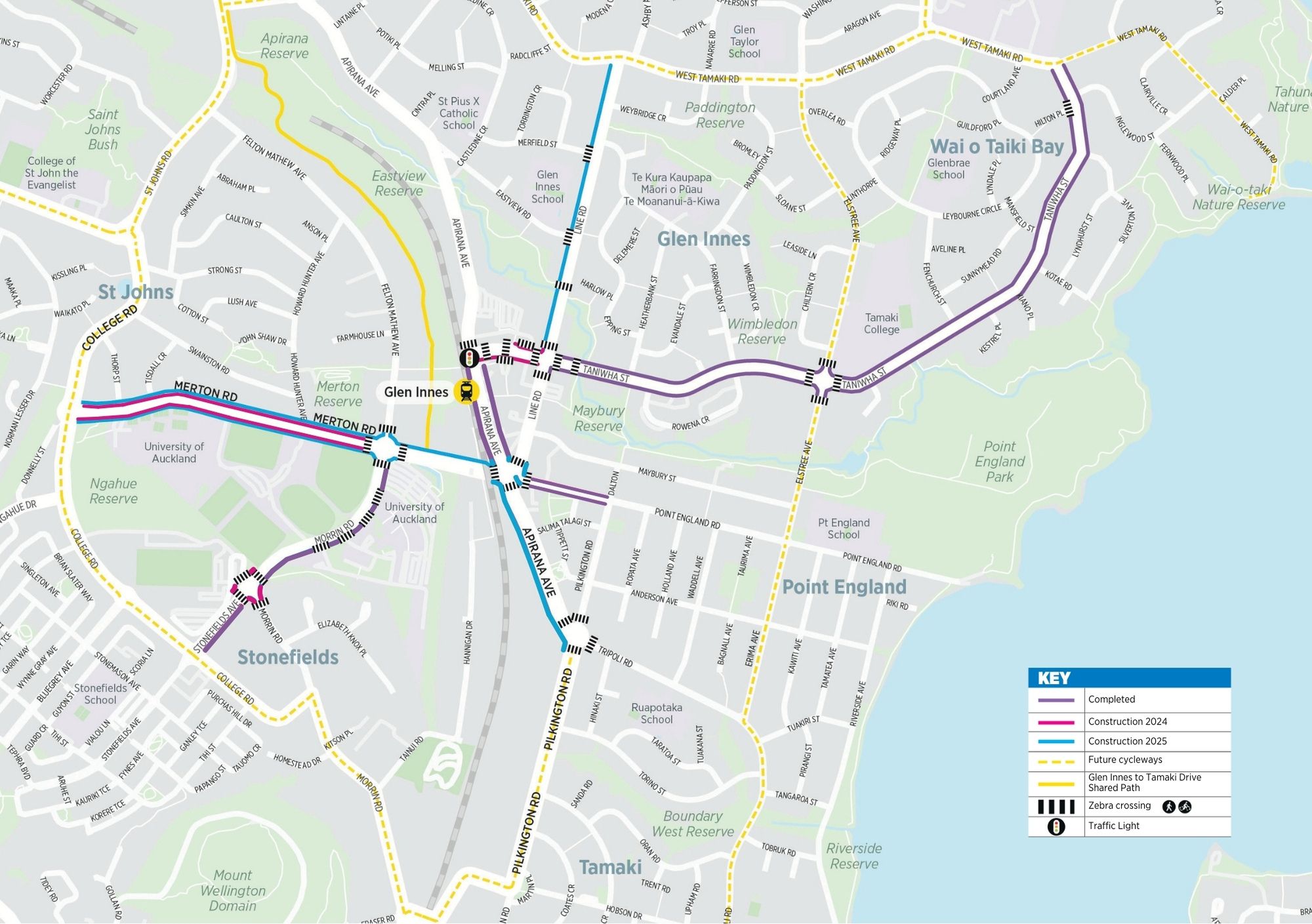Auckland Transport is consulting on an “upgrade” to the Royal Oak roundabout, which sits at the heart of what we in Bike Auckland call the “Bike Bermuda Triangle”: the central isthmus, woefully bereft of bikeways. This roundabout is notoriously hostile for people on bikes and only the bravest amongst us travel through it, whether commuting or just going to the shops.
Auckland Transport reports that this highly dangerous intersection has had 61 crashes in the last five years (2014-2018): one fatal, one serious and 14 minor injuries, plus daily near misses; most injury crashes here involve pedestrians, cyclists and motorcyclists. Not only is a safety fix well overdue, it should clearly prioritise protecting the most vulnerable.
You can see the plans here, and the project team will be at a drop-in session on Saturday 21 September, 11am to 2pm, Royal Oak Mall, Community Centre room (opposite the Food Court).
As always, here’s a handy link for feedback, plus our suggestions of what you might say. However: this one is complicated and we’re really not satisfied, so we strongly suggest you scroll down for more details.
Feedback is open until Sunday 6 October at 5pm – go for it!
Bike AKL’s feedback suggestions:
- Build the raised crossings, and make sure they’re steep enough to properly slow vehicles. Because this proposal is already so limited, it must not be watered down further by smoothing out the raised tables.
- Move the crossings closer to the roundabout, so pedestrians don’t have to double their journeys. This will also help slow down traffic in the roundabout itself, which will make it safer for people on bikes, at least somewhat.
- Upgrade the crossings on Mt Albert Road as well. These (existing) raised tables are the furthest from the intersection, and are too-gently sloped and built to outdated standards. In short, they are weak, and poor. (This is also one of the most dangerous arms of the intersection for pedestrians, see 2015, 2019)
- Remove car-parking spaces that block visibility of and for people waiting to cross and for drivers entering the roundabout. In particular, outside Ollies/ the Chip Shop and the Post Office.
- Add a second set of traffic calming treatments as cars enter the roundabout. The current design, with the significantly set-back raised crossings, allow cars to speed up again as they head into the roundabout. AT should raise the roundabout itself, so entering drivers have at least one more reminder: “don’t speed here”.
- Reduce the number of traffic lanes on the approaches and on the roundabout itself. Multi-lane roundabouts are hostile and unsafe for people walking and biking, and have no place in a residential town centre.
- (Re)widen all the footpaths around the roundabout, and add bike lanes around the roundabout. Dedicating one traffic lane to human beings walking and biking in their town centre is decades overdue and would be evidence that AT is truly committed to safety of vulnerable road users. Anything short of this is just tinkering.
The brave new context for safer, people-centred streets
When we heard AT was proposing road safety improvements to this five-armed (and historically, six-armed) vortex of busy, criss-crossing multilane roads where people also try to walk to the shops and bus stops, and others do their best to survive on a bike – we felt a tiny glimmer of hope.
After all, AT had just released its new street design guide, showing for the very first time a roundabout with proper pedestrian and cycle priority!
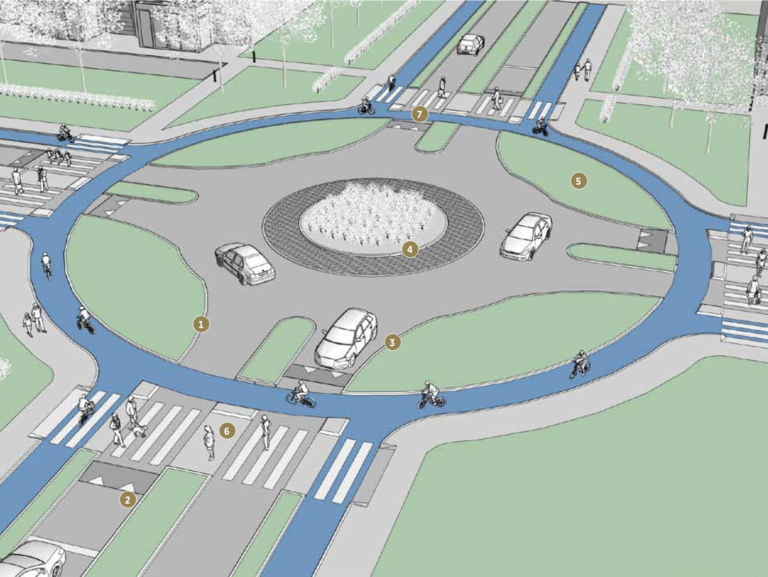
What’s more, AT also just adopted a Vision Zero safety policy, confirming its expressed determination to act “in full and without question” on the recommendations of the 2018 Howard Report into Auckland’s road safety crisis.
And yet at the same time as these strong words and guidelines, AT seems to have hit the brakes on taking action. After brave noises in 2018 about proactively reducing unsafe speeds, we have yet to see safer speeds in place as we roll towards the end of 2019. Other road safety projects are being delayed and watered down. Has action on safety entered the same mysterious gravity-well as the building of bikeways?
Which brings us back to the proposal for the Royal Oak roundabout. Instead of a shining example of the new safety approach, the design essentially does a bit of tinkering around the edges. The elephant in the room – the stampede of elephants in the middle of the circus – remains undisturbed.
What’s in AT’s proposal? One good thing…
The key safety change is the raised zebra crossings. Assuming AT uses the relatively steep designs it’s been building across the city over the last year, this will be a significant safety win.
Raised crossings reduce pedestrian crashes by 60-70%, depending on local conditions – because they make pedestrians (and their legal right of way) more visible, and because drivers have to slow down to negotiate the bump. Raised crossings make drivers less likely to bully their way through with the brute force logic of a vehicle that outmasses puny human beings by a factor of 20.
Of course, the dual lanes and high traffic volumes mean Royal Oak won’t become a pedestrian paradise overnight. But raising the crossings is a laudable move.
… and a bunch of glaring gaps
Sadly, the raised tables are also where the good news ends. The rest of the proposal is focused on moving cars. Some minor changes to traffic islands to reduce weaving between lanes in the middle of the roundabout. Two car parks removed, but not for safety as such; mostly to allow earlier access to turning lanes.
Here’s what’s not in the plan:
- Of the five roads that converge on the roundabout – ALL of which have have two lanes – not one is reduced to a single lane to make the roundabout less intimidating for people on bikes and motorbikes, or easier for pedestrians to cross.
- No lane reduction on the roundabout itself, either. Drivers will continue to frantically look for gaps in the oncoming two-lane stream of big boxy shapes, thus missing the rare smaller figures manoeuvring in between.
- None of the five pedestrian crossings moves any closer to the roundabout to become more convenient for people on foot.
- No wider footpaths for the local shops;
- No bike lanes at all.
- No bus priority, even.
- And no formal reduction in the speed limit from 50kmh.
Raised crossings aside, this is a very, very limited scheme, and it shows how little AT is still willing to touch the sacred status quo. We’re officially disappointed.
How did we get here? A visual history of this merry-go-round
Royal Oak has been an important cross-roads for a long time: six major roads meet here, although these days, “only” five of them actually lead into the roundabout itself.
And the intersection isn’t particularly large: a 25m radius circle between the buildings – not exactly tiny, but only about half the size of the Panmure roundabout, which also has six roads. (Not that the extra space available in Panmure was used for the benefit of people…)
Over the last century, the car steadily claimed more and more of this limited space at Royal Oak, at the expense of people walking, biking, catching trams.

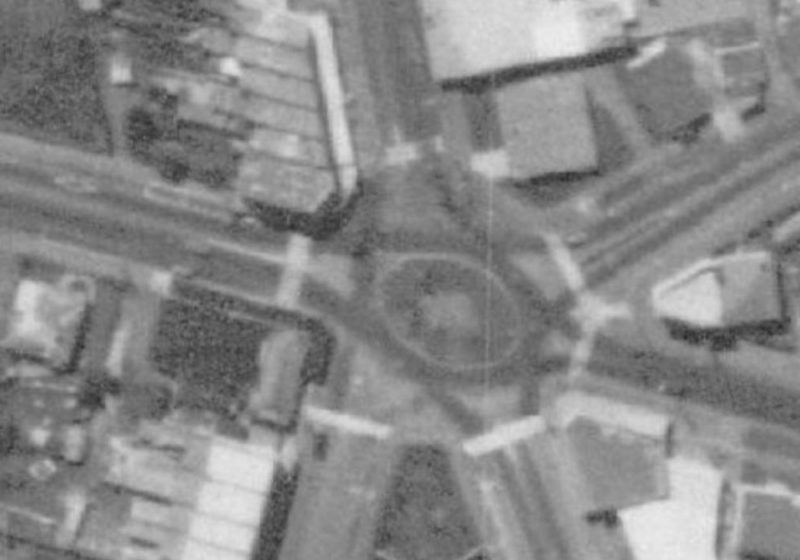
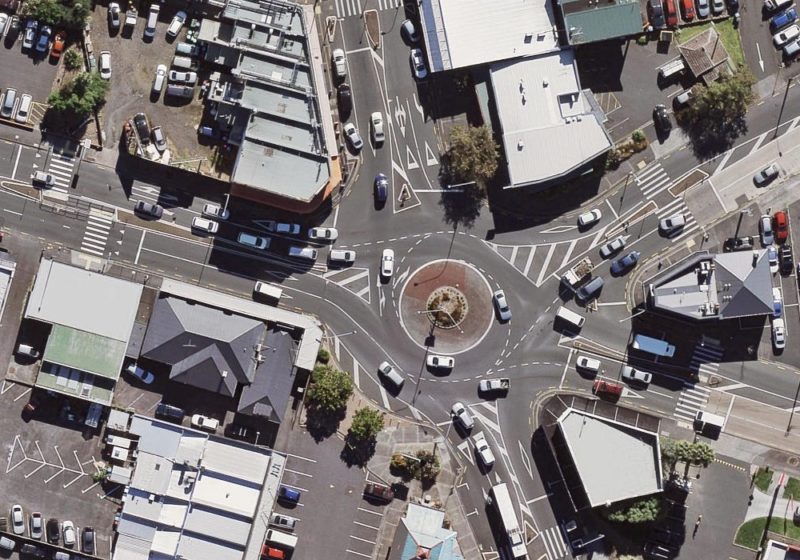
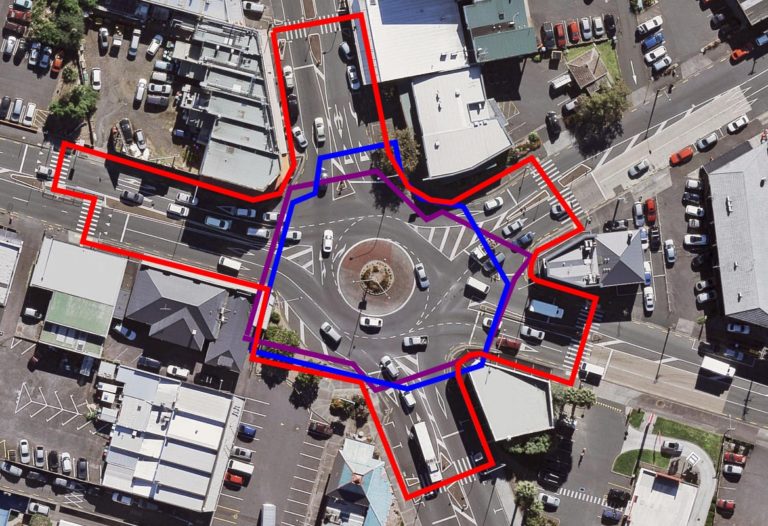
Where are we headed – is there hope on the horizon?
The current layout has been in place for 30+ years, and will barely be touched by the current project. Is it fair to burden a single road safety project with remedying all the sins of the last half century of motordom? Probably not.
We repeat: the proposed changes are good, assuming they’re not watered down through the consultation.
But they’re not good enough: this 2019 tweak ensures the heart of the town centre remains dominated by cars for the foreseeable future.
Is a more substantial 21st C safety upgrade in the offing? Well yes, in theory: Manukau Road through Royal Oak is part of AT’s Connected Communities programme, previously dubbed Integrated Corridors. The aim is to prioritise key arterial road corridors across Auckland for walking, cycling, public transport and safety, with substantial changes to roads and intersections as needed.

While the detailed principles and process of the programme aren’t clear yet, at the Royal Oak roundabout it might involve taking lanes to make space for better footpaths and bike lanes, and moving the pedestrian crossings closer-in, where they belong. Or maybe it’ll juggle vehicle flow and human beings in a constrained space by signalising the intersection, with bike lanes and better pedestrian crossings.
Either approach would need to reduce car traffic, and might even disconnect one of the five remaining arms of the intersection (discussion on the community Facebook page suggests Campbell Road as an option for closure at the roundabout end, with children’s safety top of mind). Anything is possible when “connecting communities” is your goal.
But Connected Communities is one of AT’s more… ponderous… programmes. Even in the midst of a climate and road safety crisis, the planning phase alone will take several more years, and most of the corridors on the list won’t see any works until 5-8 years beyond that – that’s assuming nothing is delayed, watered down, defunded, or otherwise quietly shelved. So, while there’s some hope on the horizon for a more humane Royal Oak roundabout sometime this century, it’s hardly soon, nor is it confirmed.
Our suggested feedback… for now
In the meantime, what’s the best way to respond to this severely limited design?
Rejecting it outright might amount to a vote for the status quo, in that we can picture a consultation summary along the lines of “most respondents said the proposal wasn’t acceptable.”
That’s why we recommend you support the design on its merits – while also demanding much better, in line with AT’s own public commitments to road safety.
Here again are our suggestions for what to say, from “most likely to happen” to “less likely, but let’s call on AT to act in accordance with its public principles”:
- Build the raised crossings – and make sure they’re steep enough to properly slow vehicles. Because this proposal is already so limited, it must not be watered down further by smoothing out the raised tables.
- Move the crossings closer to the roundabout, so pedestrians don’t have to double their journeys. This will also help slow down traffic in the roundabout itself, which will make it safer for people on bikes, at least somewhat.
- Upgrade the crossings on Mt Albert Road as well. These (existing) raised tables are the furthest from the intersection, and are too-gently sloped and built to oudated standards. In short, they are weak, and poor. (This is also one of the most dangerous arms of the intersection for pedestrians, see 2015, 2019)
- Remove car-parking spaces that block visibility of and for people waiting to cross and for drivers entering the roundabout. In particular, outside Ollies/ the Chip Shop and the Post Office.
- Add a second set of traffic calming treatments as cars enter the roundabout. The current design, with the significantly set-back raised crossings, allow cars to speed up again as they head into the roundabout. AT should raise the roundabout itself, so entering drivers have at least one more reminder: “don’t speed here”.
- Reduce the number of traffic lanes on the approaches and on the roundabout itself. Multi-lane roundabouts are hostile and unsafe for people walking and biking, and have no place in a residential town centre.
- (Re)widen all the footpaths around the roundabout and add bike lanes around the roundabout, befitting a safe, welcoming, and sustainable town centre. Dedicating one traffic lane to human beings walking and biking in and through their town centre would be clear evidence that AT is truly committed to improving the safety of vulnerable road users, via actions, not just words. Sorry to be blunt, but anything short of this is just going round in circles.
And here’s that feedback link again – add your voice before Sunday 6 October at 5pm!
Bonus section: Top ten tweets about how horrifying the Royal Oak roundabout is

